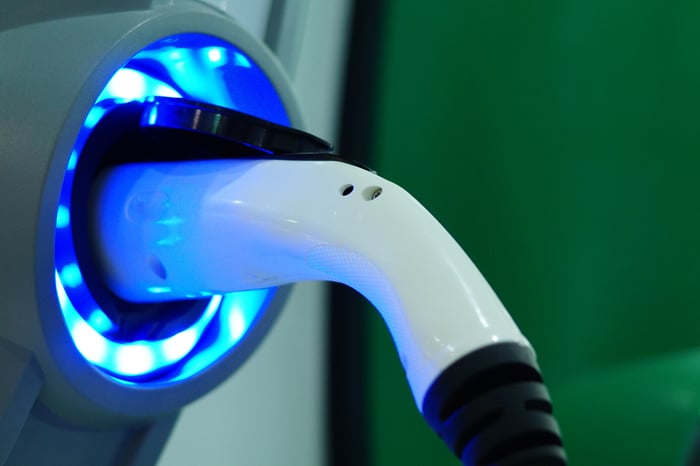Sociedad Quimica y Minera (SQM -1.59%) and Albemarle (ALB 1.27%) both saw huge stock advances in 2016 and 2017 -- and they both fell back down to Earth in 2018 and 2019, and have been on the same trajectory so far in 2020. This roller coaster ride, which has seen both fall by more than 50% from their late-2017 peaks, is all about Wall Street's attitude toward lithium, a key industrial metal used in batteries. The thing is, these two companies are, indeed, similar in many ways, but there are some key differences. And the differences might lead you to pick one over the other.
The lithium story
Both Sociedad Quimica y Minera (SQM from here on out) and Albemarle are key providers of lithium to companies around the world. The metal is used to make the batteries that are put into electric vehicles and energy storage for renewable power. In 2016 and 2017 investors were big on the electrification-of-transportation story, and bid lithium prices higher. The stocks of these two companies, as you might expect, went along for the ride. But with lithium prices skyrocketing, lithium producers started to ramp up production. Eventually, supply outstripped demand, and lithium prices cratered. Wall Street moved on to a new hot story, and the shares of both SQM and Albemarle tanked.

Image source: Getty Images
But the lithium story is far from over. The world continues to move toward electrification, with transportation expected to see a material shift away from more traditional carbon fuels in an effort to reduce greenhouse gas emissions. In fact, every major automaker has big electric vehicle plans. Building a car is a complex undertaking, and it costs a huge amount of money to start using different technology. But electrification isn't something that's going away. Albemarle, for example, expects global lithium demand to increase at a compound annual rate of 24% between 2019 and 2025, largely driven by demand from electric vehicles, which it believes will increase at an annualized rate of 38%. Both SQM and Albemarle should benefit from this trend.
Lithium prices, meanwhile, have been low, which has had a negative impact on investor sentiment and revenue at these producers. However, low lithium prices have also led to a pullback in capital spending in the industry. That, in turn, will help to get supply and demand back into balance. The downturn has been painful for both SQM and Albemarle, but the future could be much brighter. Either one of these big lithium players would get you exposure to the metal, and allow you to play the expected long-term demand that's projected in the auto space.
Similar but different
Before going too much further, it's important to note that neither of these companies is a pure play on lithium. Albemarle, for example, gets around 60% of its adjusted EBITDA from its bromines and catalyst businesses. SQM gets roughly the same amount of its gross profits from its plant nutrition, iodine, potassium, and industrial chemicals operations. There are nuances here, since the other businesses are different, but the big story is that the diversification in each case helps to balance out risk.
Where SQM and Albemarle diverge materially is in the way they go about selling lithium. SQM tends to sell more on the spot market. In other words, it is basically taking whatever the price is at the current moment. Downturns will hit its top and bottom lines more quickly. Albmearle, meanwhile, tends to make use of longer-term contracts to lock in pricing. That helps to smooth out the ups and downs, with lower lithium prices starting to hit earnings only as contracts roll-off. Both are feeling the hit from lithium price declines today, but SQM felt it more quickly.
SQM Revenue (Quarterly) data by YCharts
However, there's another side to this story. As long-term contracts roll off and Albemarle signs new contracts with lower prices, it is locking in those prices for an extended period of time. Assuming that lithium prices eventually start to move higher again in a meaningful fashion, Albemarle will have to wait for its contracts to roll off again before it can benefit. SQM, which is selling more lithium at whatever the market price happens to be, will get the upside benefit more quickly.
There are other nuances that differentiate SQM and Albemarle, but for investors interested in the lithium story, this is one of the biggest issues to think about.
Degrees of risk
There's a clear reason to believe that lithium demand, and prices, will move higher in the future. The electrification of transportation is still a big trend, even if Wall Street has moved on to different "hot investment" stories. Both SQM and Albemarle will benefit, especially since low lithium prices are leading to the investment pullbacks that are likely to get supply and demand into a better balance -- which should help support the longer-term pricing dynamics of the industrial metal. The call between these two really comes down to how an investor wants to play the space.
SQM is like rolling the dice on prices -- you get whatever the market is offering. If you're a risk taker and think a lithium upturn is imminent, that could be a good call for you. With Albemarle you are hedging your bets; when an upturn takes shape, you'll lag behind it and might not participate in the full advance. But when commodity prices get volatile, its contracts help smooth out the ride. It's a better option for more conservative investors looking to get aboard the electrification trend. Most, but not all, would probably prefer Albemarle's approach.





